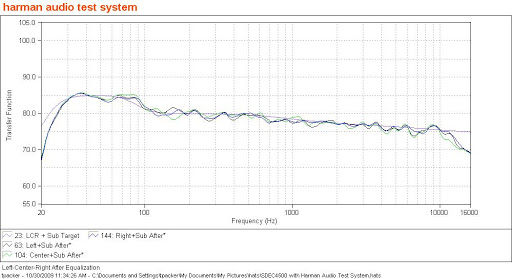(Corrected a mistake in the graph)
Thanks to @MaynardGK for noticing that!
And thanks to you for finding that diffuse field dotted line graph. I’ve been looking for it for months. Does anyone know who produced it and whether it supersedes the Hammershoi and Moeller version from 2008?
I ask because the 9k peak is very intriguing. Presumably it’s the 2nd ear canal resonance of the ISO(?) standard ear canal. But beyerdynamic gets crap for doing just that in their headphone response curves, grin.
All the graphs are now corrected, and aligned at 1khz. Enjoy! 
What? No, there’s no way. That’s still a headphone curve, that’s why it has a big hump. A perfect speaker curve is perfectly flat if measured in free field (anechoic chamber) or tilted in favor of bass by 1 dB/octave if measured in a listening room.
To be clear:
You’re right, I screwed up, sorry. Corrected:
That’s the graph I should have used.

The red curve is the ear drum response after the speakers in the Harman listening room have been EQ’d to remove room effects. It essentially matches the H&M DF curve and is there for comparison (and validation?). The same speakers would measure flat in an anechoic chamber as abm0 states.
Here are the Harman reference room measurement targets:
Notice the red-orange line (RR Standard). That huge bass hump is how they have their reference listening room tuned. When developing a loudspeakers for the home market, this is what they are shooting for. Their consumer research (directed by the famous Floyd Toole, I believe) for loudspeakers clearly showed that boosted bass sells. Their headphone research (directed by Sean Olive, a Floyd Toole student) was to find out whether this would transfer over from loudspeakers to headphones. (Clearly, it did.)
Yeah but, lol, that’s definitely not natural-sounding. I also found this (Yup, it’s from “The Measurement and Calibration of Sound Reproducing Systems”, by Floyd E. Toole).
Look at the difference between, let’s say, the “Beats” crowd versus the “Trained listeners only”. ![]()
Fig. 14:
Does anyone know where I can find the raw data points for the Harman Curve? I’ve been having a remarkably difficult time trying to find them. Having them would be useful for a side project I’m working on.
Ah perfect. I should have known the files would be on the AutoEQ Github.
Glad it’s what you wanted.
You’ll quickly discover that the data are linear below 100 Hz and logarithmic above. If you ever find a way to generate the missing logarithmic values below 100 Hz, I’d love to know about it.
Are you talking about the Harman curve points? I’m not sure what you mean. The frequency points are all logarithmically spaced apart.
I open harman_over-ear_2018.csv. The integer frequency numbers from 20 to 100 are all present in the frequency column. But after 102 frequency numbers are gradually skipped. For example, there is no 103 or 116. By the time you get up to the kilohertz range the gaps are about 10 hertz wide, and keep getting larger.
But for the samples to be logarithmic below 100, apparently there would need to be fractional-hertz sampling. Upshot: when I tell the spreadsheet to plot the raw column the curve is radically foreshortened below 100 hertz. For example:
My original question is if you need to logarithm-atize (so to speak) the 20 to 100 Hz range yourself I’d love to learn how it’s done. But certainly don’t labour over it otherwise.
Okay so the spacing between 20 Hz to 100 Hz is not correct. I think that’s an issue with your graph software. Is the chart type set to scatter plot? Is your program automatically guessing how the x axis should be configured? Maybe you need to manually configure a setting?
I’m using MS Excel and that’s not an issue I’m having.
Thanks! I’m using the on-line Google Docs spreadsheet as recommended by someone on the forum in place of the free spreadsheet that came with my MacBook. Neither seems to have sufficient configuration options to force a particular x-axis type. Not surprising that I would need to buy a full-featured product to get results like your example.
When do graphs matter? I’m guessing for audio manufactures that try and please most of the people all of the time?..we as audiophiles trust our ears and chosen source end device combinations no?
As most sites and reviewers measure, only when comparing on the same measurement rig to get a rough estimate how headphones compare.
Not all that much.
Yeah mate I do look at them… I guess it gives you and idea of what the manufacture was sonically aiming for?
On Apple products you are so restricted and limited software wise. Windows OS is much more open regarding software but restricted regarding OS itself. Linux is completely open but not all commercial softwares are supported.
If you are more knowledgeable and more tech savvy, stay away from Apple.
Mac versus PC – that takes me back about 20 years!